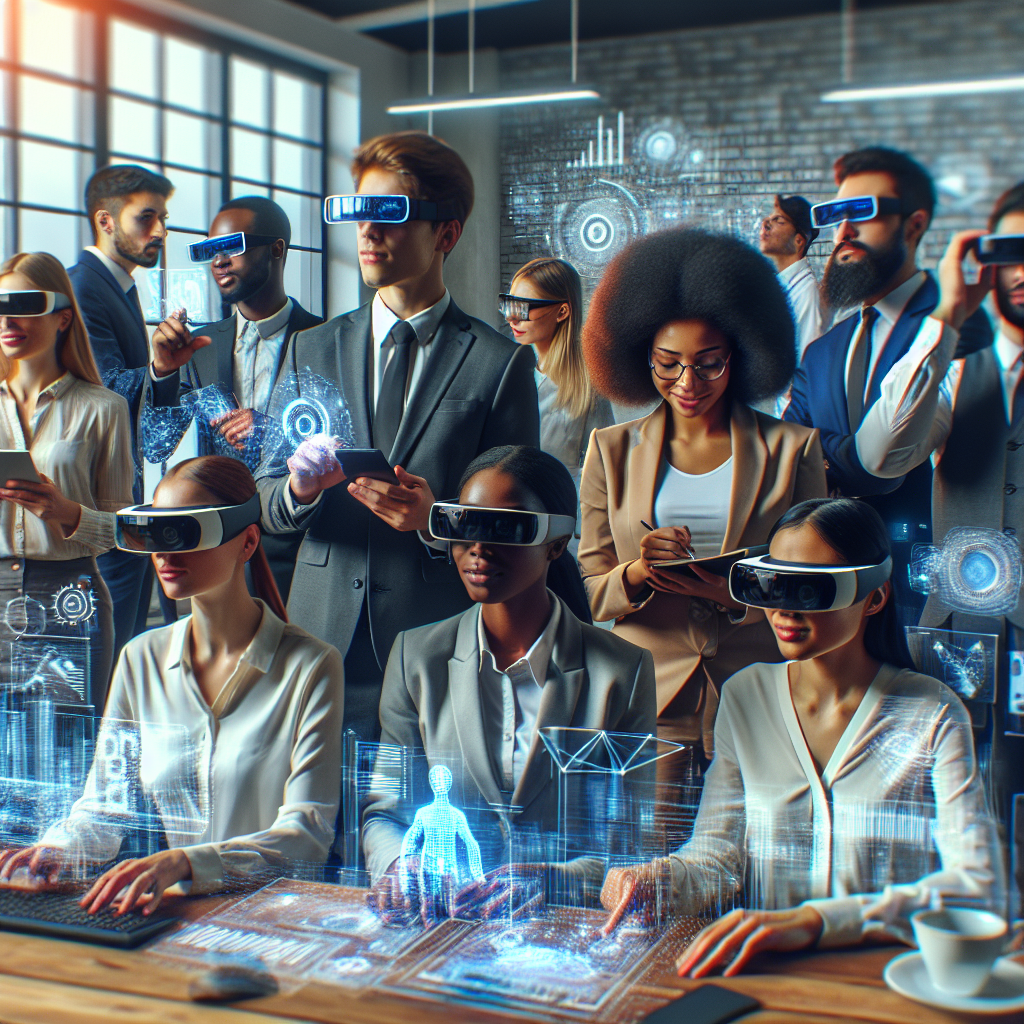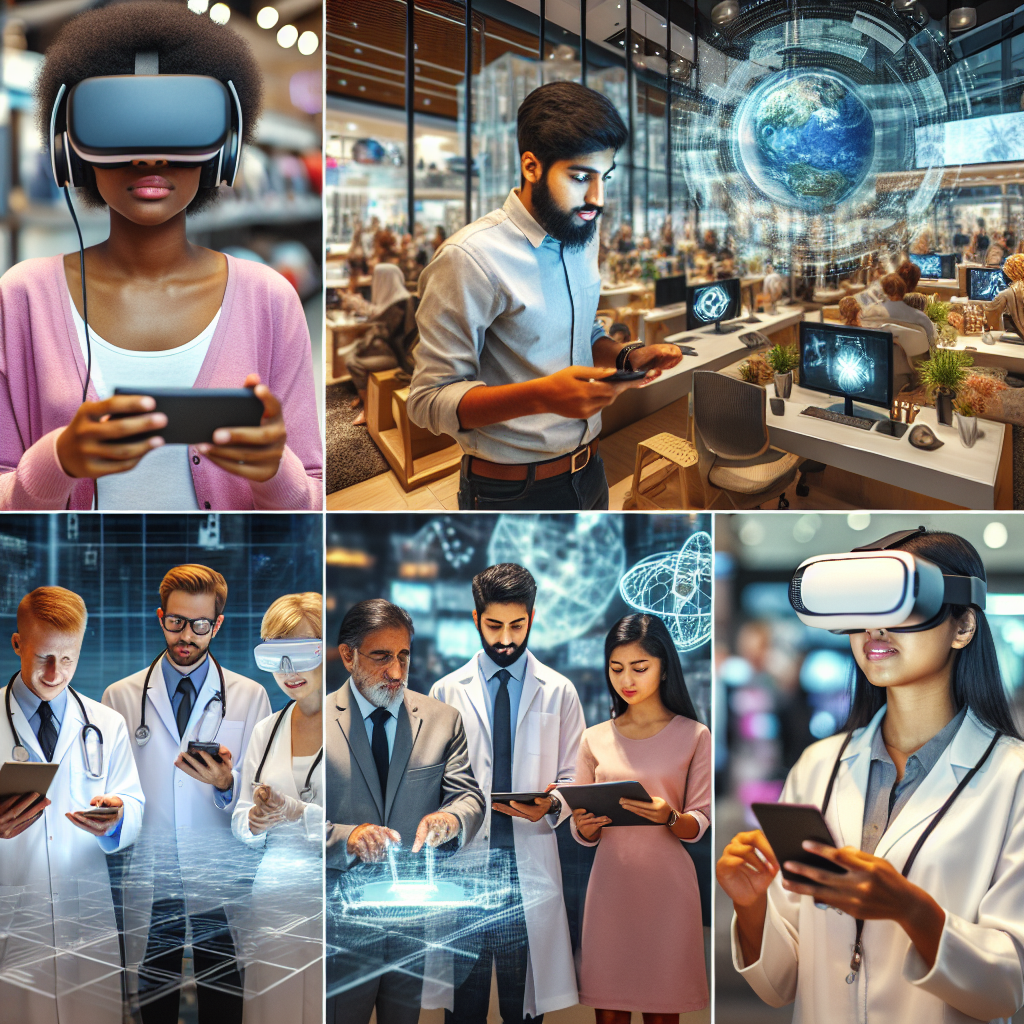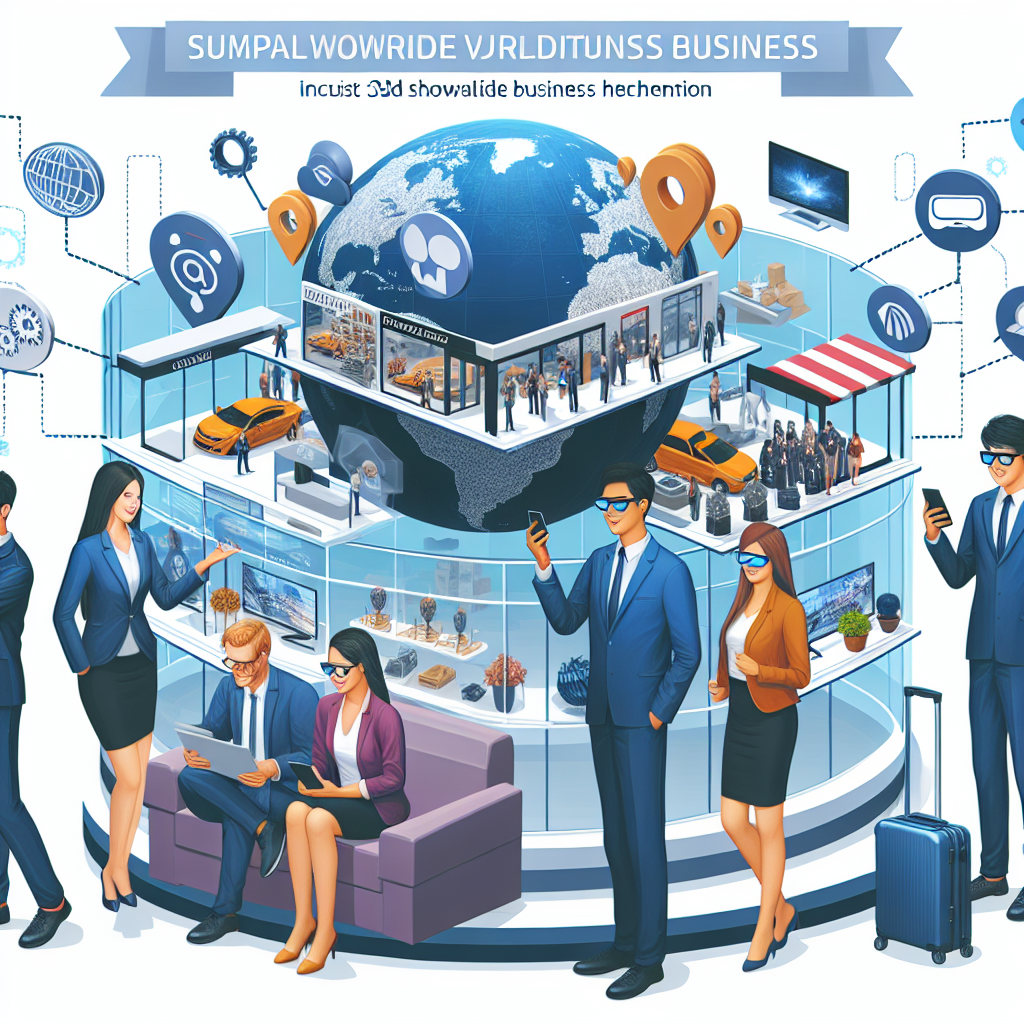Discover How Augmented Realities Impact Businesses and Explore Industries Utilizing VR and AR Technologies While Unlocking Ways to Distinguish Your Business with 3D and AR Solutions

How Does Augmented Reality Affect Business? Unlocking New Opportunities

Have you ever imagined walking into a store where you can view how a piece of furniture would look in your home before actually buying it? Or perhaps trying on clothes virtually without stepping foot into a fitting room? Thats the power of augmented reality (AR), a game-changer for businesses across various sectors. By integrating AR into their operations, companies are not only enhancing customer experience but also unlocking new revenue streams.
AR: A Gateway to Enhanced Engagement
According to recent studies, businesses that have adopted augmented reality technologies reported an average increase of 41% in customer engagement. Why does this matter? Well, engaged customers are more likely to convert into loyal ones. Imagine a car dealership that uses AR to allow potential buyers to visualize and customize their dream car. This not only attracts foot traffic but significantly boosts sales. Wouldn’t you be more inclined to buy after experiencing your perfect car in real-time?
Transforming Customer Interactions
Augmented reality is not just a fancy tool; it’s transforming the way customers interact with brands. Consider the beauty industry. Brands like LOréal have successfully integrated AR into their marketing strategies. With their virtual try-on feature, customers can see how makeup products look on them before making a purchase. This innovative approach helps reduce returns and increases customer satisfaction.
- ⭐ Increased Interactivity: Customers can engage directly with products.
- ⭐ Enhanced Visualization: Products can be seen in the user’s environment.
- ⭐ Reduced Returns: AR helps customers make informed choices.
Statistical Insights on AR in Business
| Industry | AR Adoption Rate | Customer Engagement Increase |
| Retail | 30% | 45% |
| Real Estate | 25% | 50% |
| Education | 20% | 40% |
| Healthcare | 15% | 35% |
| Travel | 10% | 30% |
With such impressive metrics, its no surprise that businesses are rushing to integrate augmented reality into their strategies. However, adopting AR is not just about new technology; it’s about understanding which industry sectors can benefit most from it.
Which Industries Are Already Using AR Technologies?
AR is making waves in several industries. Here’s how:
- ⭐️ Retail: Virtual fitting rooms and interactive catalogs.
- ⭐ Real Estate: Virtual tours allowing buyers to walk through properties remotely.
- ⭐ Healthcare: AR for surgeries and medical training.
- ⭐ Education: Interactive learning experiences that enhance understanding.
Such applications not only help businesses stand out from their competition but also empower customers to make better purchasing decisions.
Ways to Distinguish Your Business Using AR
So, how can you leverage AR effectively? Here are three innovative strategies:
- ⭐ Create Immersive Brand Experiences: Use AR to give customers a deeper connection with your brand. Think of gamifying a shopping experience!
- ⭐ Incorporate Customer Feedback: Use AR to visualize how customer suggestions are integrated into products or services.
- ⭐ Analyze Customer Interaction Data: Utilize data generated from AR interactions to tailor marketing strategies.
Such techniques can set your business apart in a crowded marketplace. Remember, AR is not just a trend; it’s shaping the future of customer engagement.
If youre ready to transform your business with the power of augmented reality, contact us today! Give us a call at [email protected] or visit our website artivale.com. Our team of professional specialists, with over 20 years of experience, is eager to provide all services you need in one place! Let’s unlock new opportunities together. ⭐
Which Industries Are Already Using VR and AR Technologies? A Look at Real-World Applications

Have you ever wondered how virtual reality (VR) and augmented reality (AR) technologies are reshaping industries right before our eyes? These cutting-edge technologies are not just for gaming anymore; they are becoming essential tools for various sectors, providing innovative solutions to age-old problems. From enhancing retail shopping experiences to revolutionizing training in healthcare, VR and AR are driving transformation across different industries.
Retail: Enhancing the Shopping Experience
The retail sector has wholeheartedly embraced AR technologies. Imagine walking into a store and using your smartphone to visualize how a piece of furniture will look in your home, all without lifting a finger. Brands like IKEA have successfully implemented AR apps that allow customers to see a 3D model of their products in their own spaces through their smartphones. This kind of immersive experience not only attracts customers but significantly boosts sales, making customers feel confident in their purchases.
Real Estate: Virtual Property Tours
In real estate, VR offers prospective buyers the ability to tour properties from the comfort of their homes. With platforms like Matterport, real estate agents can create 3D virtual tours, allowing clients to navigate through homes without physically being there. This has proven especially beneficial during times like the COVID-19 pandemic, enabling buyers to make decisions faster while reducing physical contact. Such innovations help real estate agencies stand out in a competitive market.
- ⭐ Increased Sales: Properties sell 30% faster when offered through virtual tours.
- ⭐ Broader Audience Reach: Reach international buyers who may not travel to view properties.
Education: Interactive Learning Environments
The education sector is witnessing a revolution thanks to VR and AR technologies. Imagine a biology class where students can explore the human anatomy in 3D. Companies like zSpace are utilizing AR to create immersive learning experiences that enhance engagement and understanding. Students can manipulate models of complex systems, making learning more interactive and fun.
Key Benefits in Education
- ⭐ Improved Retention Rates: Students retain information better when engaging in interactive learning.
- ⭐ Tailored Learning Experiences: Educators can customize content based on different learning styles.
Healthcare: Training and Patient Care
In healthcare, VR and AR technologies are being used for both training and patient care. Surgical simulations can provide medical professionals with practical experience before they step into an operating room. For instance, companies like Osso VR allow surgeons to practice their skills through realistic simulations, ultimately improving patient outcomes.
- ⭐ Enhanced Training: Surgeons can practice complex procedures multiple times.
- ⭐⚕️ Better Patient Trust: Patients can visualize their procedures in a VR setup, reducing anxiety.
Automotive: Virtual Showrooms and Test Drives
The automotive industry is also leveraging AR to offer immersive experiences to potential buyers. Companies like Audi and BMW have developed interactive showrooms where customers can visualize car features and customize their vehicles in real time. Additionally, VR test drives enable customers to experience a vehicle without being on the road. This kind of innovative marketing not only enhances customer satisfaction but also leads to increased conversions.
Automotive AR Benefits
- ⭐ Reduced Time in Showrooms: Customers can explore options without visiting multiple dealerships.
- ⭐ Innovative Brand Image: Companies adopting AR stand out as forward-thinking and customer-centric.
Gaming and Entertainment: Pushing Boundaries
Of course, the gaming industry was among the first adopters of VR and AR technologies. Games like Pokémon GO have brought AR into the mainstream, allowing players to interact with virtual characters in their real-world environments. The immersive nature of VR gaming offers players experiences impossible to replicate in traditional formats, enhancing entertainment value.
Conclusion: The Future is Here
As we can see, the applications of VR and AR technologies span across multiple industries and are redefining how businesses operate. From providing enhanced customer experiences to improving training methods, the possibilities are endless. If your company wants to be at the forefront of these technological advancements, now is the time to act. Contact us at [email protected] or visit our website artivale.com to explore how we can help leverage these technologies for your business! ⭐
Ways to Distinguish a Business Using 3D and AR: Innovative Strategies for Success

Ready to take your business to new heights? In todays competitive landscape, standing out is not just an option – it’s a necessity. Enter 3D and AR technologies. These tools are not just gadgets; they are transformative strategies that can redefine how customers interact with your brand. Lets explore how you can leverage these technologies to distinguish your business and boost your success.
1. Creating Immersive Customer Experiences
Imagine walking into a retail store where you can interact with products through an AR application. Customers can visualize how furniture looks in their homes or see how clothing fits without ever trying it on. This immersive experience not only enhances customer satisfaction but also significantly reduces the likelihood of return rates. For instance, companies like Sephora have successfully implemented AR technology that allows customers to "try on" makeup virtually, creating an interactive and engaging shopping experience. ⭐
2. Offering Visualization Tools
In industries like real estate, 3D models and virtual walkthroughs can be game-changers. Imagine potential buyers touring properties from the comfort of their homes through VR or AR. This visual tool allows clients to experience space and design in a way that photos alone cannot convey. Platforms like Matterport capitalize on this by offering detailed 3D scans of properties, increasing engagement and helping clients make faster purchasing decisions. ⭐
- ✨ Enhance Engagement: Capture more interest with unique visualizations.
- ⭐ Accelerate Sales: Turn views into offers with immersive experiences.
3. Personalizing Marketing Efforts
Personalization is key to customer loyalty, and AR can help. By using customer data to tailor interactive experiences, businesses can create targeted campaigns that resonate more deeply with their audience. For example, Nike has developed AR features that help customers design their shoes according to personal preferences. This not only creates a unique shopping experience but also fosters brand loyalty. ⭐
Key Benefits of Personalized Marketing
- ⭐ Improve Customer Retention: Tailor offerings to match individual preferences.
- ⭐ Boost Conversion Rates: Personalized experiences are more compelling.
4. Utilizing AR for Training and Development
Training employees has never been more interactive! AR technologies can simulate real-world scenarios, allowing employees to engage in hands-on training without the risks associated with traditional methods. For instance, manufacturing firms can provide VR simulations for new machinery operation, significantly enhancing learning efficiency and safety. This not only prepares your staff better but also boosts their confidence. ⭐️
5. Leverage 3D Content for Enhanced Communication
Sometimes, visual communication is far more effective than text-based content. By producing 3D animations or AR-infused videos, you can convey complex messages in a simple, engaging way. For example, companies in the tech industry often use 3D models to demonstrate product features. This strategy not only makes the information more accessible but also engages clients in a more dynamic manner. ⭐
6. Enhancing Customer Service with AR
AR can also be used to improve customer service. Imagine a scenario where a customer encounters issues with a product. Instead of waiting on hold for support, they can scan the product with their smartphone and receive step-by-step guidance through AR overlays. Companies like IKEA have implemented similar technology, providing customers with immediate support and enhancing their experience. This proactive approach can lead to higher customer satisfaction. ⭐
Benefits of Using AR in Customer Service
- ⭐️ Reduce Support Costs: Fewer resources spent on customer inquiries.
- ⭐ Increase Customer Satisfaction: Immediate assistance boosts goodwill.
7. Breathtaking Advertising Campaigns
Finally, AR opens up new avenues in advertising. Brands can create interactive advertisements that allow customers to engage with their products in a compelling way. Imagine pointing your phone at a billboard to see a 3D model of the product, or even to unlock a special discount by engaging with the ad. Companies like Pepsi have used AR in playful advertising campaigns, leading to higher engagement rates and a memorable brand presence. ⭐
Incorporating 3D and AR technologies into your business strategy can distinguish your brand, enhancing customer experiences and driving sales. The possibilities are limitless, and early adopters reap the most significant rewards. If you are ready to revolutionize your business, contact us at [email protected] or visit our website artivale.com. Let’s discuss how we can create these innovative experiences together! ⭐
Submit your details in the form and our team will personally get in touch with you within the next business day to discuss your needs
